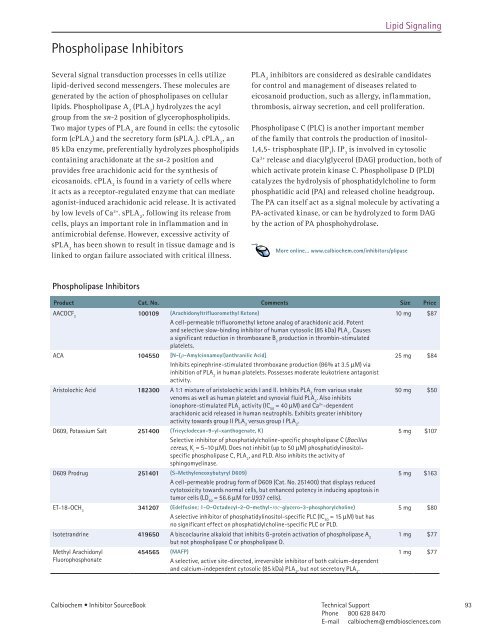Inhibitor SourceBook™ Second Edition
Inhibitor SourceBook™ Second Edition
Inhibitor SourceBook™ Second Edition
Create successful ePaper yourself
Turn your PDF publications into a flip-book with our unique Google optimized e-Paper software.
Phospholipase <strong>Inhibitor</strong>s<br />
Several signal transduction processes in cells utilize<br />
lipid-derived second messengers. These molecules are<br />
generated by the action of phospholipases on cellular<br />
lipids. Phospholipase A 2 (PLA 2 ) hydrolyzes the acyl<br />
group from the sn-2 position of glycerophospholipids.<br />
Two major types of PLA 2 are found in cells: the cytosolic<br />
form (cPLA 2 ) and the secretory form (sPLA 2 ). cPLA 2 , an<br />
85 kDa enzyme, preferentially hydrolyzes phospholipids<br />
containing arachidonate at the sn-2 position and<br />
provides free arachidonic acid for the synthesis of<br />
eicosanoids. cPLA 2 is found in a variety of cells where<br />
it acts as a receptor-regulated enzyme that can mediate<br />
agonist-induced arachidonic acid release. It is activated<br />
by low levels of Ca 2+ . sPLA 2 , following its release from<br />
cells, plays an important role in inflammation and in<br />
antimicrobial defense. However, excessive activity of<br />
sPLA 2 has been shown to result in tissue damage and is<br />
linked to organ failure associated with critical illness.<br />
Phospholipase <strong>Inhibitor</strong>s<br />
Calbiochem • <strong>Inhibitor</strong> SourceBook<br />
Lipid Signaling<br />
PLA 2 inhibitors are considered as desirable candidates<br />
for control and management of diseases related to<br />
eicosanoid production, such as allergy, inflammation,<br />
thrombosis, airway secretion, and cell proliferation.<br />
Phospholipase C (PLC) is another important member<br />
of the family that controls the production of inositol-<br />
1,4,5- trisphosphate (IP 3 ). IP 3 is involved in cytosolic<br />
Ca 2+ release and diacylglycerol (DAG) production, both of<br />
which activate protein kinase C. Phospholipase D (PLD)<br />
catalyzes the hydrolysis of phosphatidylcholine to form<br />
phosphatidic acid (PA) and released choline headgroup.<br />
The PA can itself act as a signal molecule by activating a<br />
PA-activated kinase, or can be hydrolyzed to form DAG<br />
by the action of PA phosphohydrolase.<br />
Product Cat. No. Comments Size Price<br />
AACOCF 3 100109 (Arachidonyltrifluoromethyl Ketone)<br />
A cell-permeable trifluoromethyl ketone analog of arachidonic acid. Potent<br />
and selective slow-binding inhibitor of human cytosolic (85 kDa) PLA 2 . Causes<br />
a significant reduction in thromboxane B 2 production in thrombin-stimulated<br />
platelets.<br />
ACA 104550 [N-(p-Amylcinnamoyl)anthranilic Acid]<br />
Inhibits epinephrine-stimulated thromboxane production (86% at 3.5 mM) via<br />
inhibition of PLA 2 in human platelets. Possesses moderate leukotriene antagonist<br />
activity.<br />
Aristolochic Acid 182300 A : mixture of aristolochic acids I and II. Inhibits PLA 2 from various snake<br />
venoms as well as human platelet and synovial fluid PLA 2 . Also inhibits<br />
ionophore-stimulated PLA 2 activity (IC 50 = 40 mM) and Ca 2+ -dependent<br />
arachidonic acid released in human neutrophils. Exhibits greater inhibitory<br />
activity towards group II PLA 2 versus group I PLA 2 .<br />
D609, Potassium Salt 251400 (Tricyclodecan-9-yl-xanthogenate, K)<br />
Selective inhibitor of phosphatidylcholine-specific phospholipase C (Bacillus<br />
cereus, K i = 5– 0 mM). Does not inhibit (up to 50 mM) phosphatidylinositolspecific<br />
phospholipase C, PLA 2 , and PLD. Also inhibits the activity of<br />
sphingomyelinase.<br />
D609 Prodrug 251401 (S-Methyleneoxybutyryl D609)<br />
A cell-permeable prodrug form of D609 (Cat. No. 25 400) that displays reduced<br />
cytotoxicity towards normal cells, but enhanced potency in inducing apoptosis in<br />
tumor cells (LD 50 = 56.6 mM for U937 cells).<br />
ET- 8-OCH 3 341207 (Edelfosine; 1-O-Octadecyl-2-O-methyl-rac-glycero-3-phosphorylcholine)<br />
A selective inhibitor of phosphatidylinositol-specific PLC (IC 50 = 5 mM) but has<br />
no significant effect on phosphatidylcholine-specific PLC or PLD.<br />
Isotetrandrine 419650 A biscoclaurine alkaloid that inhibits G-protein activation of phospholipase A 2<br />
but not phospholipase C or phospholipase D.<br />
Methyl Arachidonyl<br />
Fluorophosphonate<br />
More online... www.calbiochem.com/inhibitors/plipase<br />
454565 (MAFP)<br />
A selective, active site-directed, irreversible inhibitor of both calcium-dependent<br />
and calcium-independent cytosolic (85 kDa) PLA 2 , but not secretory PLA 2 .<br />
0 mg $87<br />
25 mg $84<br />
50 mg $50<br />
5 mg $ 07<br />
5 mg $ 63<br />
5 mg $80<br />
mg $77<br />
mg $77<br />
Technical Support<br />
Phone 800 628 8470<br />
E-mail calbiochem@emdbiosciences.com<br />
93



